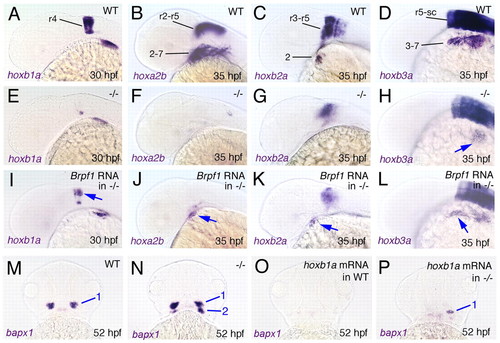
Brpf1 regulates segmental identity by maintaining anterior Hox gene expression. Whole-mount in situ hybridizations with the probes indicated bottom left at the stages indicated bottom right; genotypes and treatment of zebrafish embryos as indicated in upper right corners. (A-L) Lateral views; (M-P) ventral views. (A-D) Hox gene expression in wild type (WT). Hox-expressing hindbrain rhombomeres (r) and arch-forming cranial neural crest (CNC) (2-7) are indicated. sc, spinal cord. (E-H) Absent or reduced Hox gene expression in brpf1 mutants (-/-). Arrow in H indicates the remaining hoxb3a expression in the posterior CNC. (I-L) Partially rescued Hox gene expression in the hindbrain (I, arrow) and the CNC (J-L, arrows) of brpf1 mutants injected with mouse Brpf1 mRNA. (M-P) The bimandibular phenotype of the brpf1 mutant (N) can be overcome by injection of hoxb1a mRNA. (O) hoxb1a-injected wild-type embryo lacking bapx1 expression, indicative for bihyoid phenotype [compare with Hunter and Prince (Hunter and Prince, 2002)]. (P) hoxb1a-injected brpf1 mutant with bihyoid pattern on left side and wild-type pattern on right side. Arch numbers are indicated.
|

